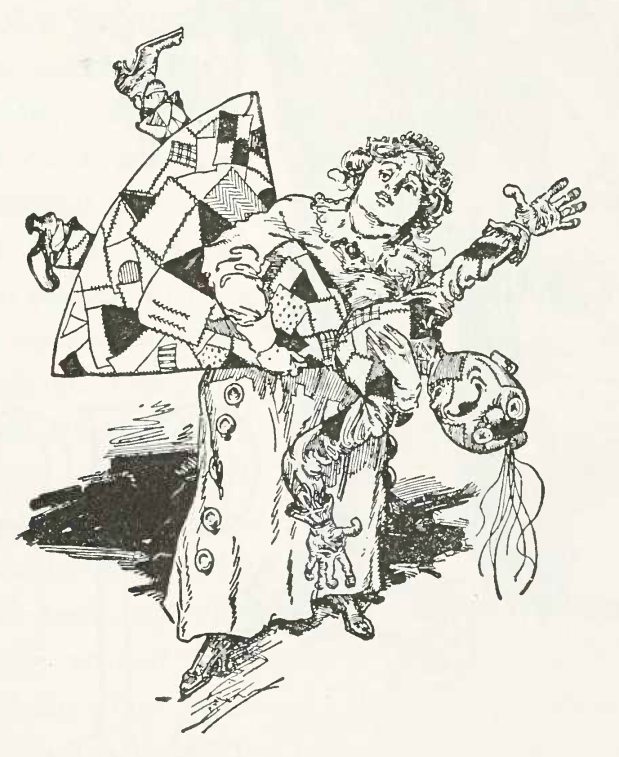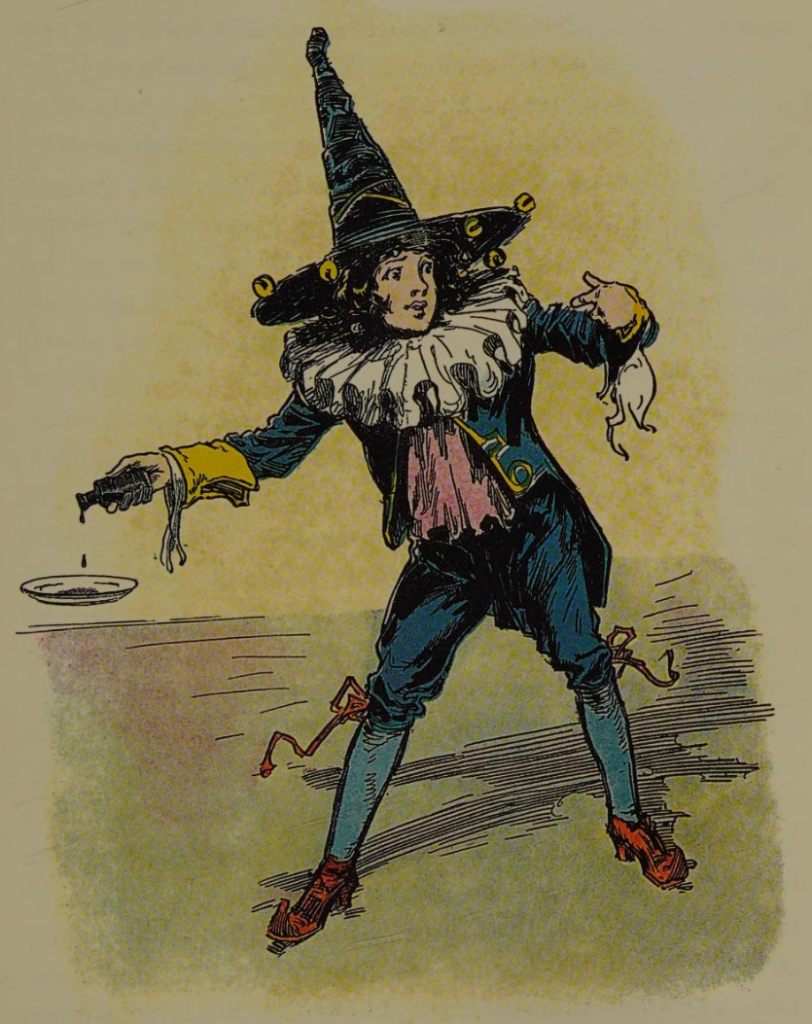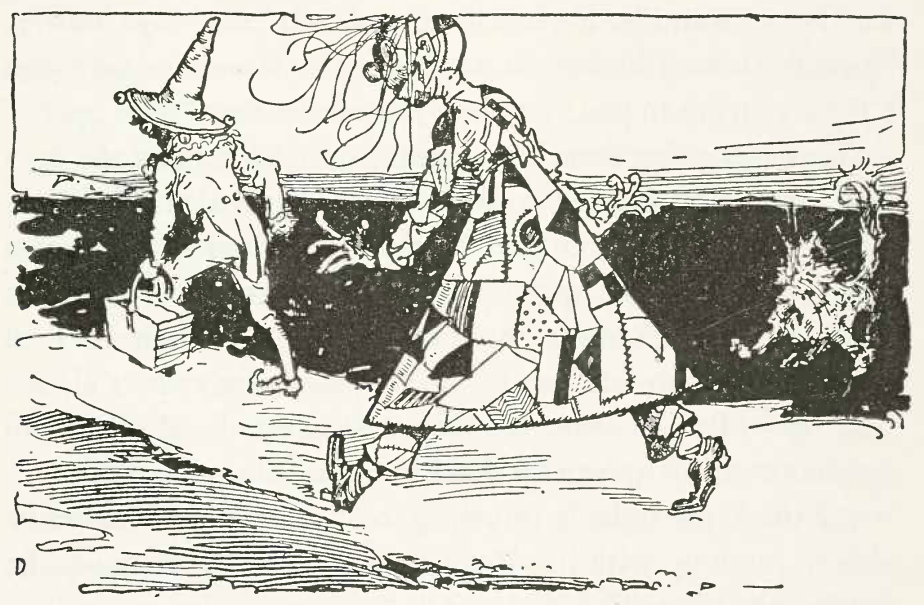So they are poor, yes, but they are still royalty. It feels like if Baum cared to revise his texts, he would have made Dorothy a relative of the Tudors. There is no reason for this detail, either, as it never comes up again and is of no relevance to the story. It is also strange because, in earlier novels, each of the four countries of Oz has its own ruler who simply ranks lower than Ozma. This is still the case in The Patchwork Girl itself, where the Tin Woodman remains the Emperor of the Winkies. Moreover, “the Monarch of the Munchkins” attends Ozma’s birthday party in The Road to Oz. Fan fiction brain might imagine that Unc Nunkie was opposed to unification and got deposed as a result, replaced with this unidentified monarch.
Desperate for food, these two isolated weirdos walk through the wilderness to the house of another weirdo, Dr. Pipt, the “crooked magician” who lives with his wife, Margolotte. Ozma has banned the practice of magic, excepting Glinda and the Wizard (230), so even the Good Witch of the North gets screwed over. The truth is that this character has just stopped existing because Baum forgot about her.

Weirdly, Dr. Pipt, a wizard, can’t help but praise Ozma for banning magic: “Too many people were working magic in the Land of Oz, and so our lovely Princess Ozma put a stop to it. I think she was quite right. There were several wicked Witches who caused a lot of trouble” (42). Magic has to be illegal or the status quo might be challenged again, and nothing is more precious than the status quo. Because there are no police in Oz to search for Dr. Pipt, he has continued his illegal practices and insists he has a right to create artificial beings if he wants to, just that he cannot legally do magic for other people. Ojo and Unc Nunkie happen to find Dr. Pipt finishing up a batch of the Powder of Life to animate a human-sized, colorful patchwork ragdoll to become Margolotte’s slave. This is not me applying edgier language—Margolotte calls the Patchwork Girl her slave.
These sleazy marginalized wack jobs, including a surly Glass Cat Dr. Pipt earlier brought to life “because the meat cats drink too much milk” (208), prepare to awaken the Patchwork Girl. However, Ojo thinks it “both unfair and unkind” to limit her psychological functions so that she can be only an automaton. He discreetly “[takes] down every bottle [of personality] on the shelf and pour[s] some of the contents in Margolotte’s dish [of liquid brains]” (40).

As a result, when the Patchwork Girl springs to life, she is raucous, creative, intelligent, defiant, and overflowing with chaotic energy. In her first moments, she causes Unc Nunkie to accidentally tip Dr. Pipt’s bottle of Liquid of Petrification, which spills on Unc Nunkie and Margolotte, turning them to stone. Recall that Mombi threatened to work this kind of magic six books ago (though I took it as trying to scare Tip rather than as a sincere intention, a degree of subtlety I no longer think Baum capable of).
Ojo pushed the Patchwork Girl away and ran to Unc Nunkie, filled with a terrible fear for the only friend and protector he had ever known. When he grasped Unc’s hand it was cold and hard. Even the long gray beard was solid marble. The Crooked Magician was dancing around the room in a frenzy of despair, calling upon his wife to forgive him, to speak to him, to come to life again! (56)
The Patchwork Girl rejects the name “Angeline” that Margolotte intended, instead deeming herself “Scraps” (queer allegory). In her joy to be conscious and queer, Scraps isn’t much concerned with what has happened and, displaying her good brains already, suggests Dr. Pipt just use the Powder of Life to reanimate the petrified people. Creating more powder will require “six long, weary years if stirring four kettles with both feet and both hands” (60). However, there is another compound that could break the petrification spell. Unfortunately, this potion requires a six-leaved clover, the left wing of a yellow butterfly, “a gill of water from a dark well” that light has never touched, three hairs from the tip of a Woozy’s tail, and a drop of oil from a live man’s body. Dr. Pipt does not know what the last three ingredients of this list even are.
Ojo sets out to explore Oz for the first time to find every item in the recipe. Scraps joins him. When Dr. Pipt insists she stay as his servant, the cloth homunculus claims she is serving him by helping break the petrification magic. The Glass Cat also tags along, claiming she is intelligent enough to help but really just hating life with Dr. Pipt and hoping to learn more about the world. So begins the adventure with these argumentative oddballs to whom the Land of Oz is scarcely less new than it was to Dorothy in The Wonderful Wizard. They set off down the Yellow Brick road to find the six-leaved clover outside the Emerald City, though they will not be welcome because Ozma has banned the picking of such clover. We have a proper quest with clear, specific goals and emotional stakes for the characters! Incredible! I thought Baum had forgot narrative structure exists after Ozma of Oz.
Messy, strange, evocative, and moving, these first five chapters alone contain more personality and drama than the whole of the previous two books. Sadly, despite initial promise, The Patchwork Girl fails to deliver on most of its thematic and narrative threads. I do not blame people who like this novel, as it is so much more entertaining compared to The Road to Oz and The Emerald City of Oz that a reader who has torn through each, one after another, would find The Patchwork Girl water in a desert. The book also introduces, well, the Patchwork Girl, one of the more likable characters.
